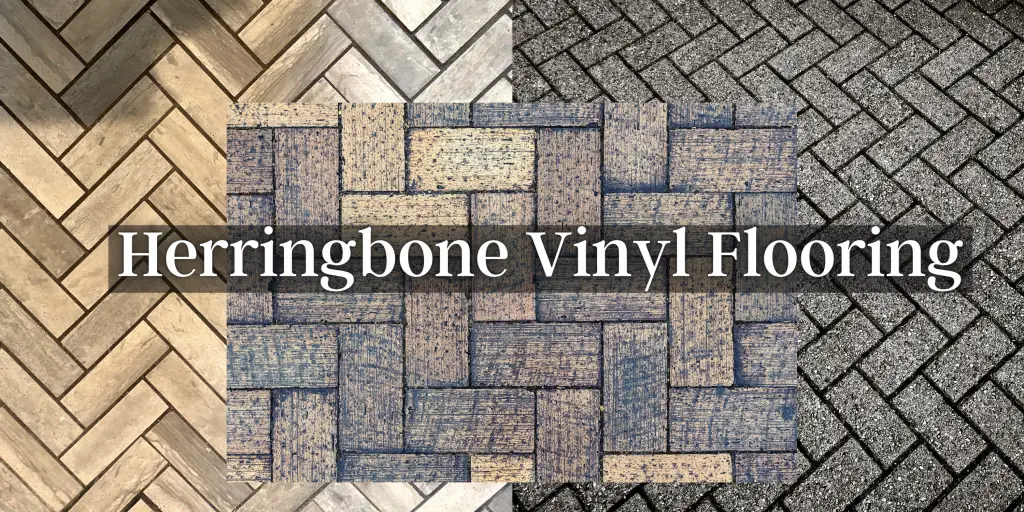Looking for a durable and beautiful flooring solution? Look no further than herringbone vinyl flooring. This stylish pattern can be used in a variety of applications, from kitchens to bathrooms to living rooms. Plus, it’s easy to install and requires little maintenance.
Herringbone vinyl flooring is a popular pattern to use in decorating. It is so versatile, it can be applied as flooring, backsplash, and countertop covering. Unlike other tiles that have to be cut through points, you can install Herringbone Vinyl Flooring without any hassles by using a straight cutting method. The trick is knowing how to line up the tiles properly for an attractive finish.
Installing this type of tile is not as difficult as you might think, and with the help of these tips, you’ll have your herringbone-style floor looking fabulous in no time!
Another interesting read: How Long Does Retro Vinyl Flooring Last For?
What Is the Herringbone Pattern?
The herringbone design gets its name because this pattern looks a lot like the bones of a fish. Any rectangular floor or wall material including wood, brick, tile, and vinyl can be used to create this unique pattern, and the same basic products like adhesives or grout are used.
The planning for these chevron patterns is a little bit more complex than installing straight lines on your floors because the ties that fit around the edges of a room usually need to be cut at a precise angle, and the starting point of creating this pattern is quite complex. However, it’s totally worth it because the final result of this floor type is much more interesting and luxurious than your average straight line tile floor.
Before You Install Herringbone Vinyl Flooring:
Use a straight board as your guide for alignment Cut the first piece of vinyl tile with a jigsaw level out the seams before you start laying down more pieces Apply construction adhesive between each row for a secure installation.
Step 1: Use a Straight Board as Your Guide for Alignment
The trick to lining up herringbone tiles is to use a straight board as your guide. A level of some sort will help you keep the alignment perfect every time.
Step 2: Cut the First Piece of herringbone vinyl flooring with a Jigsaw
Use a jigsaw with a fine-tooth blade that can cut through the vinyl tile. The tile needs to sit flush against each other when they are installed, so there is no gap for grout.
Step 3: Level Out Seams Before You Start Laying Down More Pieces
A slight variation in height could create an unsightly hump in the flooring. Use self-leveling caulk or construction adhesive and level out seams before laying down more pieces of vinyl tile along with the pattern you have chosen.
Step 4: Apply Construction Adhesive Between Each Row for a Secure Installation
Some tile floors may require construction adhesive between each row to keep them secure. When the tiles are not secured properly, there is a greater chance of movement which can cause cracks in your floors. As your tile installer, we recommend that you ask about the best installation process for your project so you get the best results possible.
Looking for a durable and beautiful flooring solution? Look no further than herringbone vinyl flooring. This stylish pattern can be used in a variety of applications, from kitchens to bathrooms to living rooms. Plus, it’s easy to install and requires little maintenance.
How to Lay Vinyl Tile in a Herringbone Pattern
Herringbone vinyl tile patterns can be used in your bathroom, kitchen, living room, and other common areas you need flooring. For the most attractive results, use a straight-cutting method when laying down individual tiles. You’ll find more detailed instructions below.
Step 1
To ensure proper adhesion, it is always best to start on a freshly cleaned floor. Vinyl flooring can be installed over other floor types like tile or concrete, but you will need to sweep and wash the surface before laying the adhesive vinyl tiles on top.
Step 2
Before you lay your first tile, you should plan out the corners, sides, or the starting point because the cutting angle may differ depending on which direction you want the pattern to follow. It is always best to start in the far corner of a room and keep building your pattern from this point on.
Step 3
It is very important to make clean and straight cuts when you need to shorten or shape tiles for the corners or sides of the floor. Use a jigsaw or circular saw and measure out your cutting angle and cut lengths before each cut.
Step 4
Some types of vinyl flooring tiles need to be adhered to the floor using an adhesive. Interlocking vinyl floor tiles are sometimes installed without adhesives, but many people still prefer to adhere them to the floor. Vinyl floor tiles are usually glued to the floor with an acrylic-based adhesive, and this layer is applied before pressing the tile down onto the floor.
Step 5
Vinyl flooring tiles need to be coated with an acrylic based adhesive on all sides. Line connecting sides of the floor tile with the adhesive as you build your floor.
Step 6
Acrylic based adhesives are very difficult to remove once dried. You should keep an old rag close by and keep cleaning any excess fluids from the floor tiles as you work.

Is It Hard to Install Vinyl Tile in This Style?
Aside from using a jigsaw to cut around curves or corners, installing herringbone is quite easy. It’s easier than installing traditional tile because there’s no cutting required. Just line up the seams and add adhesive to make it stick, and you’re good to go.
Types of Vinyl Tile Available
You can find herringbone-pattern vinyl tile in a variety of styles and colors, including:
Tile that looks like stone flagstone, slate, or cobblestone tiles.
Tile that resembles high-end porcelain tiles made from natural materials such as wood or ceramic.
Vinyl flooring with a wide plank format makes an attractive addition to your living room or bedroom floors.
What Construction Adhesive Is Best for Vinyl Tile?
Construction adhesive is what gives herringbone vinyl flooring its durability and lets you avoid using grout between tiles. You need special glue that works with vinyl flooring. Ask your local home center about which adhesives work best for this particular surface.
Where to Use Vinyl Tile in a Herringbone Pattern
Herringbone-patterned vinyl tiles are becoming increasingly popular, which means their availability is growing. You’ll find them in home centers, online, and at independent dealers. Here are three of the most common places to use these attractive tiles:
Kitchen Floors
Instead of ceramic tile, match herringbone floors to your cabinet hardware for an up-to-date look that still provides plenty of grips underfoot. These durable tiles stand up well to spills and scratches because they’re usually resistant to moisture and mold growth. Plus, they make cleanup easy because they repel dirt.
Bathroom Floors
Herringbone Vinyl Flooring can add a touch of elegance to an otherwise functional area because they’re available in upscale styles and colors. They’re also easy to install and care for, which makes them perfect for bathrooms. This kind of flooring is especially nice in the master bath or powder room where you don’t want to spend time cleaning grout between tile pieces.
Living Room Floors
For the living room, pick herringbone vinyl flooring that look like hardwood planks or stone flagstones. The pattern works well with seagrass rugs and earth-tone upholstery for a cohesive design theme. Coordinate your furniture style with your floors, and know that you can replace the entire floor with ease down the road if you get tired of it.
Summary
Herringbone vinyl flooring is available in attractive styles and colors, so they can add a touch of elegance to an otherwise functional kitchen or bathroom flooring. They’re easy to install and maintain making them ideal for the bathroom as well. This kind of flooring is especially nice in the master bath or powder room where you don’t want to spend time cleaning grout between tile pieces.
For the living room, pick vinyl herringbone tiles that look like hardwood planks or stone flagstones. The pattern works well with seagrass rugs and earth-tone upholstery for a cohesive design theme. Coordinate your furniture style with your floors, and know that you can replace the entire floor with ease down the road if you get tired of it.
You can find herringbone-pattern vinyl tile in a variety of styles and colors, including Tile that looks like stone flagstone, slate, or cobblestone tiles Tile that resembles high-end porcelain tiles made from natural materials such as wood or ceramic Vinyl flooring with a wide plank format that makes an attractive addition to your living room or bedroom floors.
Final Thoughts
We hope that you found this vinyl flooring guide useful. Now, you can install your beautiful vinyl floors with ease! If you plan on taking on other handyman tasks around the house, then you should have a look at some of the other guides we have on Healthy Handymen. You can learn to do just about anything using the articles on our site.

